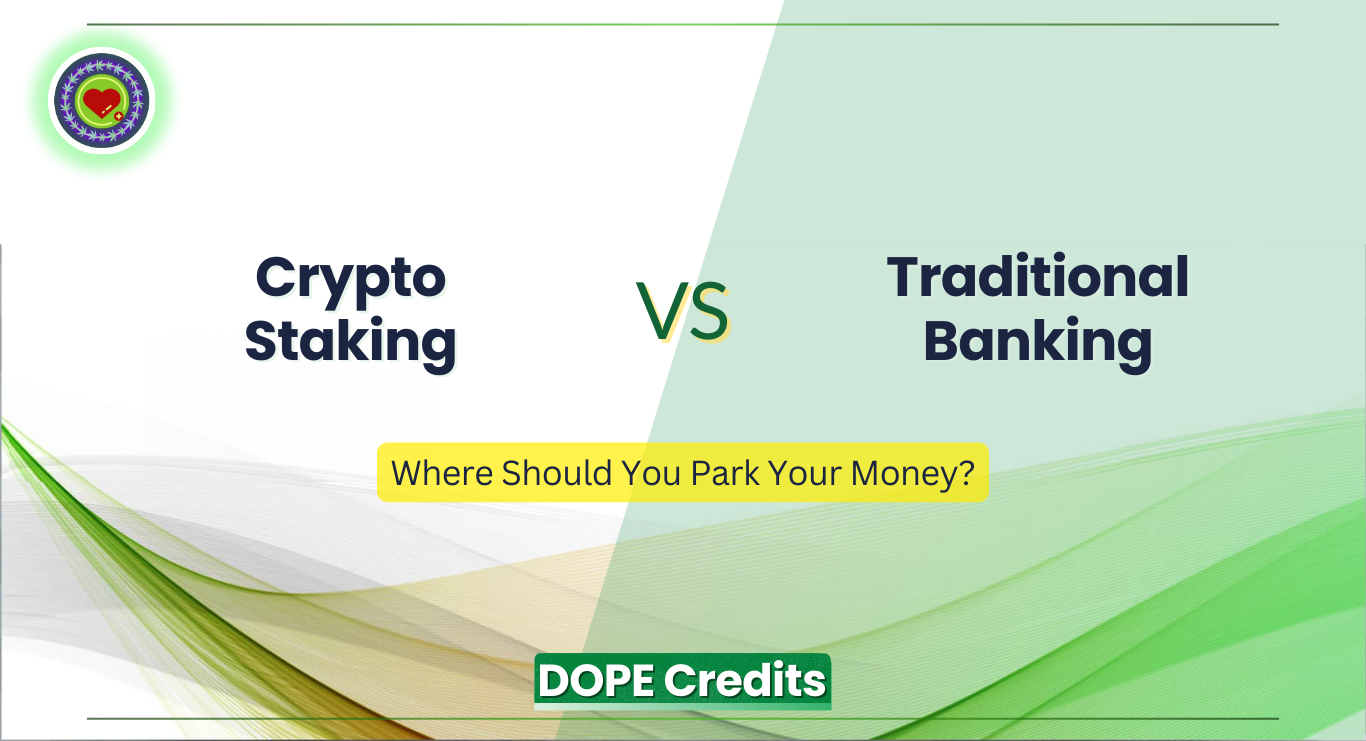From the Blogs
Learn how to grow your business with our expert advice.

Crypto Staking vs. Traditional Banking: Where Should You Park Your Money?
When it comes to growing wealth, people have traditionally relied on savings accounts. These accounts have long been considered a safe and stable way to store money while earning a small amount of interest over time. However, the emergence of cryptocurrency staking has presented an alternative that offers significantly higher returns. This raises an important question: Is it better to keep your money in a traditional savings account, or should you consider staking your crypto assets?
In this guide, we’ll compare staking vs savings accounts, breaking down the pros and cons of each to help you decide where to park your money.
Understanding Traditional Savings Accounts
A savings account is a bank account that allows you to deposit money while earning interest on your balance. These accounts are considered low-risk because they are usually insured by government programs, such as the Federal Deposit Insurance Corporation (FDIC) in the U.S. or similar institutions in other countries.
How Savings Accounts Work
- You deposit money into a savings account.
- The bank pays you interest on your balance, typically on a monthly or yearly basis.
- Your funds remain accessible, though some accounts may have withdrawal limits.
- The bank uses your deposits to issue loans and make investments, profiting from the difference in interest rates.
While savings accounts provide security, they have a major drawback: low interest rates. The average annual percentage yield (APY) on savings accounts typically ranges between 0.01% and 2%, depending on the bank and economic conditions. Even high-yield savings accounts rarely exceed 4% APY.
Understanding Crypto Staking
Crypto staking is a process in which you lock up your cryptocurrency holdings to support a blockchain network’s operations, such as transaction validation. In return, you receive staking rewards, usually in the form of additional tokens. Unlike traditional savings accounts, staking operates on decentralized blockchain networks, eliminating the need for banks as intermediaries.
How Staking Works
- You hold a cryptocurrency that supports staking, such as Dope Credits or other Proof-of-Stake (PoS) tokens.
- You stake (lock up) your tokens in a staking platform or directly on the blockchain.
- The network uses your staked tokens to validate transactions and maintain security.
- In return, you receive staking rewards, typically on a daily, weekly, or monthly basis.
Staking can offer significantly higher returns compared to savings accounts. Many staking platforms provide APYs ranging from 5% to over 30%, depending on the token and network conditions.
Comparing Savings Accounts and Crypto Staking
To understand the differences between savings accounts and crypto staking, let’s compare them across key factors:
Annual Yield (APY) | 0.01% - 4% | 5% - 36.5%
Risk Level | Low | Medium
Liquidity | High (can withdraw anytime) | Varies (some have lock-up periods)
Inflation Protection | Poor | Strong (if crypto appreciates)
Accessibility | Easy (any bank) | Requires crypto knowledge
Government Regulation | Fully regulated | Mostly unregulated
Earning Frequency | Monthly or yearly | Daily, weekly, or monthly
Clearly, staking has the potential to offer much higher returns compared to savings accounts, but it also comes with additional risks.
Pros and Cons of Traditional Savings Accounts
Pros:
- Safety and Stability – Your funds are protected by government insurance.
- Liquidity – Withdraw money anytime without penalties.
- Easy to Use – No technical knowledge is required.
- No Market Volatility – Your balance remains stable regardless of financial markets.
Cons:
- Low Interest Rates – Earnings are minimal, often failing to outpace inflation.
- Bank Fees – Some accounts have maintenance fees that eat into savings.
- Inflation Risk – Over time, rising inflation can devalue the purchasing power of money in savings accounts.
- Bank Control – Banks can impose withdrawal limits, freeze accounts, or restrict access during financial crises.
Pros and Cons of Crypto Staking
Pros:
- High Returns – APYs from staking often exceed those of traditional savings accounts.
- Passive Income – Earn rewards without actively trading.
- Decentralization – No middlemen; you maintain control of your funds.
- Inflation Protection – If the price of your staked crypto increases, your earnings grow exponentially.
Cons:
- Market Volatility – Crypto prices can fluctuate, affecting the value of staked assets.
- Lock-Up Periods – Some staking platforms require assets to be locked for a fixed duration.
- Regulatory Uncertainty – Crypto regulations are evolving, which could impact staking.
- Technical Complexity – New users may find crypto staking platforms harder to navigate compared to banks.
Earnings Example: Staking vs. Savings Account
Let’s compare earnings with a $10,000 deposit in both a traditional savings account and a crypto staking platform like Dope Credits.
Scenario 1: Savings Account (APY = 2%)
- Year 1 Earnings: $200
- Year 3 Earnings: $612 (assuming compounded interest)
- Year 5 Earnings: $1,040
Scenario 2: Staking Dope Credits (APY = 36.5%)
- Year 1 Earnings: $3,650 worth of DOPE tokens
- Year 3 Earnings: $11,822 (assuming no price increase)
- Year 5 Earnings: $21,148
The difference is clear. Staking offers significantly higher earnings, assuming stable or rising token prices.
Which Option is Right for You?
Choosing between a traditional savings account and crypto staking depends on your financial goals and risk tolerance.
- If you prioritize safety and accessibility, a savings account is a better choice. It protects your funds from volatility and provides guaranteed, albeit small, returns.
- If you want higher rewards and are comfortable with market fluctuations, crypto staking is an excellent way to grow your wealth. Platforms like Dope Credits offer high-yield staking with daily rewards, making it a lucrative option for those seeking passive income.
Final Thoughts
Both traditional savings accounts and crypto staking have their advantages and drawbacks. Savings accounts are low-risk but offer minimal returns, while staking provides high rewards with some level of volatility. If you are looking to maximize your earnings, staking vs savings account is not even a fair competition—staking wins in terms of profitability.
That said, diversifying your investments is always a smart strategy. You may choose to keep part of your wealth in a secure savings account while allocating a portion to staking opportunities like Dope Credits to take advantage of higher returns.
As the financial world continues to evolve, the choice between banks and blockchain will become even more relevant. Whether you prefer the security of traditional banking or the high returns of staking, it is essential to make informed decisions that align with your financial goals.
